在FPGA设计中,线性序列机和状态机思想是十分重要的思想方法,用于实现各种时序要求。这次的内容是实现用FPGA,时钟周期为20ns,每间隔5000ns发送一个字节的数据,数据不从外部接入,而是内部给定。本着模块化设计原则,整体结构如下:

子模块为ctrl和data_send,顶层为data_send_top。
data_send模块在en信号的同步下实现数据的发送,每50个时钟周期发送一个bit,发送完成后拉高一个时钟周期的tx_done。
ctrl模块根据tx_done信号来控制数据发送的间隔,同时指定要发送的数据data。
一、data_send设计与仿真
逻辑设计
对于data_send要求50个时钟周期发一个bit,采用线性序列机实现,实现一个最大值为50个时钟周期的计数器1,再实现一个对计数器1的溢出次数进行计数的计数器2,是个模8计数器(但为了生成tx_done以及不在0时刻发送data数据,这里实现的是模9计数器),后面的逻辑根据计数器2的计数值按时将数据放在数据线上即可。这就是线性序列机的思想,在实际应用中,往往要生成一组信号来满足某些控制器的时序,可以找到这些信号的变化最小时间单位,类似得实现计数器1,再实现计数器2,最后根据时序灵活安排数据发送得时刻即可。
module data_send
(
input wire clk ,
input wire rst_n ,
input wire en ,
input wire [7:0] data ,
output reg tx ,
output wire tx_done
);
reg [7:0] cnt;//计数器1
reg [4:0] cnt_add; //计数器2
always@(posedge clk or negedge rst_n)
if(!rst_n)
cnt <= 8'd0;
else if(en)
if(cnt == 8'd49)
cnt <= 8'd0;
else
cnt <= cnt + 1'b1;
else
cnt <= 8'd0;
always@(posedge clk or negedge rst_n)
if(!rst_n)
cnt_add <= 5'd0;
else if(en) begin
if(cnt_add == 5'd9)
cnt_add <= 5'd0;
else if(cnt == 8'd49)
cnt_add <= cnt_add + 1'b1;
end
else
cnt_add <= 5'd0;
//序列机实现
always@(posedge clk or negedge rst_n)
if(!rst_n)
tx <= 1'b0;
else
case(cnt_add)
5'd1 : tx <= data[0];
5'd2 : tx <= data[1];
5'd3 : tx <= data[2];
5'd4 : tx <= data[3];
5'd5 : tx <= data[4];
5'd6 : tx <= data[5];
5'd7 : tx <= data[6];
5'd8 : tx <= data[7];
default : tx <= 1'b0;
endcase
//tx_done信号生成
always@(posedge clk or negedge rst_n)
if(!rst_n)
tx_done <= 1'b0;
else if(cnt_add == 5'd9)
tx_done <= 1'b1;
else
tx_done <= 1'b0;
endmoduletb
`timescale 1ns/1ns
`define clk_period 20
module data_send_tb;
//============================<端口>==============================
reg clk;
reg rst_n;
reg en;
reg [7:0] data;
wire tx;
wire tx_done;
//================================================================
//== 模块例化
//================================================================
data_send data_send_inst0
(
.clk (clk),
.rst_n (rst_n),
.en (en),
.data (data),
.tx (tx),
.tx_done (tx_done)
);
//================================================================
//== 时钟信号
//================================================================
initial clk = 1'b1;
always #(`clk_period/2) clk = ~clk;
//================================================================
//== 设计输入信号
//================================================================
initial begin
rst_n = 0;
en = 0;
data = 8'h00;
#201;
rst_n = 1;
#201;
data = 8'h23;
en = 1;
#20000;
en = 0;
#5000;
data = 8'h56;
en = 1;
#20000;
en = 0;
#5000;
$stop;
end
endmodulemodelsim仿真
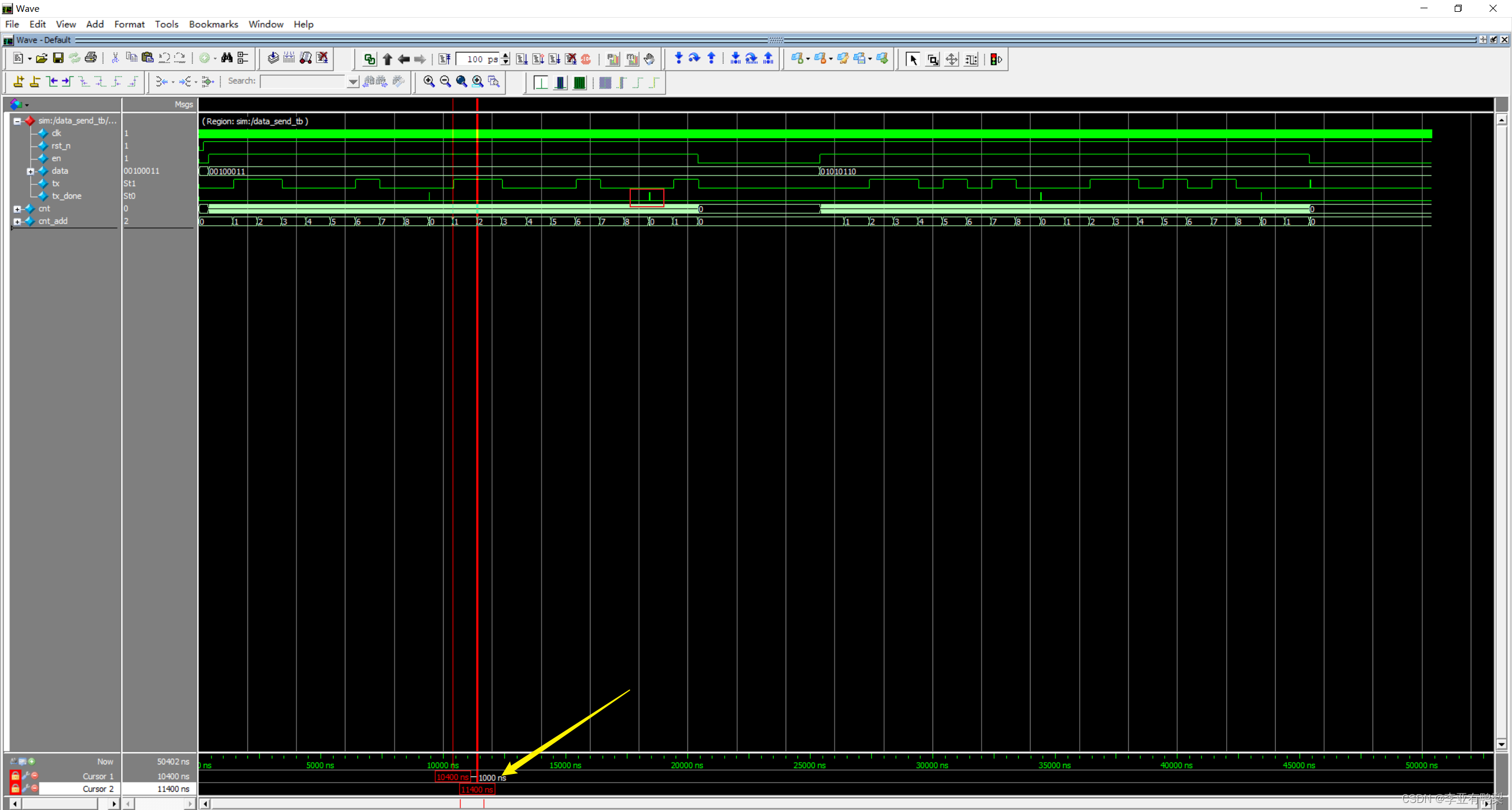
可以看到,发送完第八个字节后,拉高了一个时钟周期的tx_done,测量一个bit发送时间为50*20=1000ns,符合设计要求。
二、ctrl模块设计与仿真
逻辑设计
在这个模块中,由于tx_done信号需要data_send模块产生,而data_send需要ctrl的en信号来启动发送,故采用状态机来实现ctrl模块。
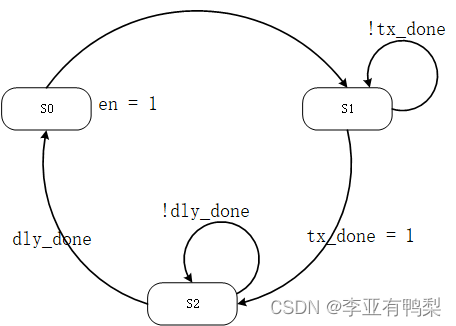
S0中en = 1,让data_send模块工作。
S1中等待tx_done信号有效。
S2中等待5000ns(250个时钟周期)。
module ctrl
(
input wire clk ,
input wire rst_n ,
input wire tx_done ,
output reg en ,
output reg [7:0] data
);
reg [11:0] cnt; //50us计数器
reg cnt_en;
reg dly_done;
reg [1:0] state;
localparam S0 = 3'd0;
localparam S1 = 3'd1;
localparam S2 = 3'd2;
always@(posedge clk or negedge rst_n)
if(!rst_n)begin
state <= S0;
cnt_en <= 1'b0;
en <= 1'b0;
data <= 8'd0;
end
else begin
case(state)
S0 : begin
en = 1'b1 ;
data <= 8'h12;
state <= S1;
end
S1 : begin
if(tx_done) begin
state <= S2;
cnt_en <= 1;
en <= 0;
end
else begin
en <= 1;
cnt_en <= 0;
state <= S1;
end
end
S2 : begin
if(!dly_done) begin
state <= S2;
cnt_en <= 1;
end
else begin
cnt_en = 0;
state <= S0;
end
end
default : begin
state <= S0;
cnt_en <= 0;
en = 0;
end
endcase
end
always@(posedge clk or negedge rst_n)
if(!rst_n)
cnt <= 12'd0;
else if(cnt_en)begin
if(cnt == 12'd249)
cnt <= 12'd0;
else
cnt <= cnt + 1'b1;
end
else
cnt <= 12'd0;
always@(posedge clk or negedge rst_n)
if(!rst_n)
dly_done <= 1'b0;
else if(cnt == 12'd249)
dly_done <= 1'b1;
else
dly_done <= 1'b0;
endmoduletb
`timescale 1ns/1ns
`define clk_period 20
module ctrl_tb;
//============================<端口>==============================
reg clk;
reg rst_n;
reg tx_done;
wire en;
wire [7:0] data;
//================================================================
//== 模块例化
//================================================================
ctrl ctrl_inst0
(
.clk (clk),
.rst_n (rst_n),
.tx_done (tx_done),
.en (en),
.data (data)
);
//================================================================
//== 时钟信号
//================================================================
initial clk = 1'b1;
always #(`clk_period/2) clk = ~clk;
//================================================================
//== 设计输入信号
//================================================================
initial begin
rst_n = 0;
tx_done = 0;
#201;
rst_n = 1;
#201;
tx_done = 1;
#20;
tx_done = 0;
#8000;
tx_done = 1;
#20;
tx_done = 0;
#8000;
$stop;
end
endmodulemodelsim仿真
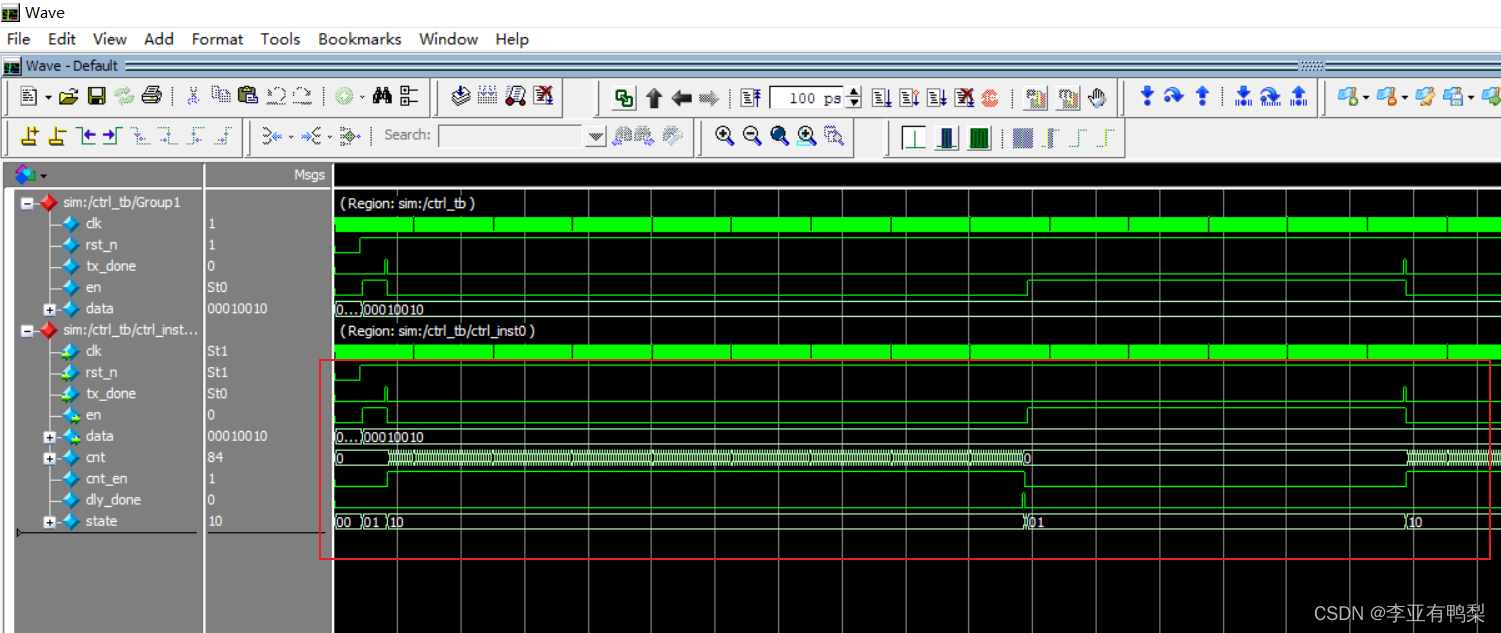
可以看到,状态机可以正常工作。
三、ctrl模块设计与仿真
按照架构图在data_send_top例化即可。
逻辑设计
module data_send_top
(
input wire clk ,
input wire rst_n ,
output wire tx
);
wire en;
wire [7:0] data;
wire tx_done;
data_send data_send_inst0
(
.clk (clk),
.rst_n (rst_n),
.en (en),
.data (data),
.tx (tx),
.tx_done (tx_done)
);
ctrl ctrl_inst0
(
.clk (clk),
.rst_n (rst_n),
.tx_done (tx_done),
.en (en),
.data (data)
);
endmoduletb
`timescale 1ns/1ns
`define clk_period 20
module data_send_top_tb;
//============================<端口>==============================
reg clk;
reg rst_n;
wire tx;
//================================================================
//== 模块例化
//================================================================
data_send_top data_send_top_inst
(
.clk (clk),
.rst_n (rst_n),
.tx (tx)
);
//================================================================
//== 时钟信号
//================================================================
initial clk = 1'b1;
always #(`clk_period/2) clk = ~clk;
//================================================================
//== 设计输入信号
//================================================================
initial begin
rst_n = 0;
#201;
rst_n = 1;
#200000;
end
endmodule
modelsim仿真
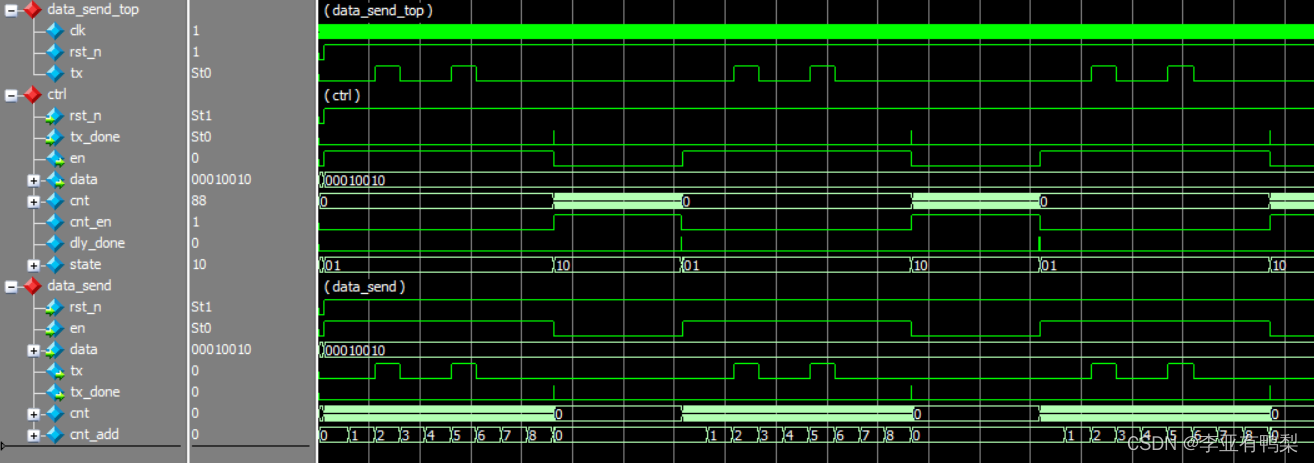
仔细观察,发现整体是可以正常工作的。
优化
在观察中,发现在ctrl中,从tx_done信号为高到发出en = 1信号,时间并不是严格的5000ns,而是多了3个时钟周期。
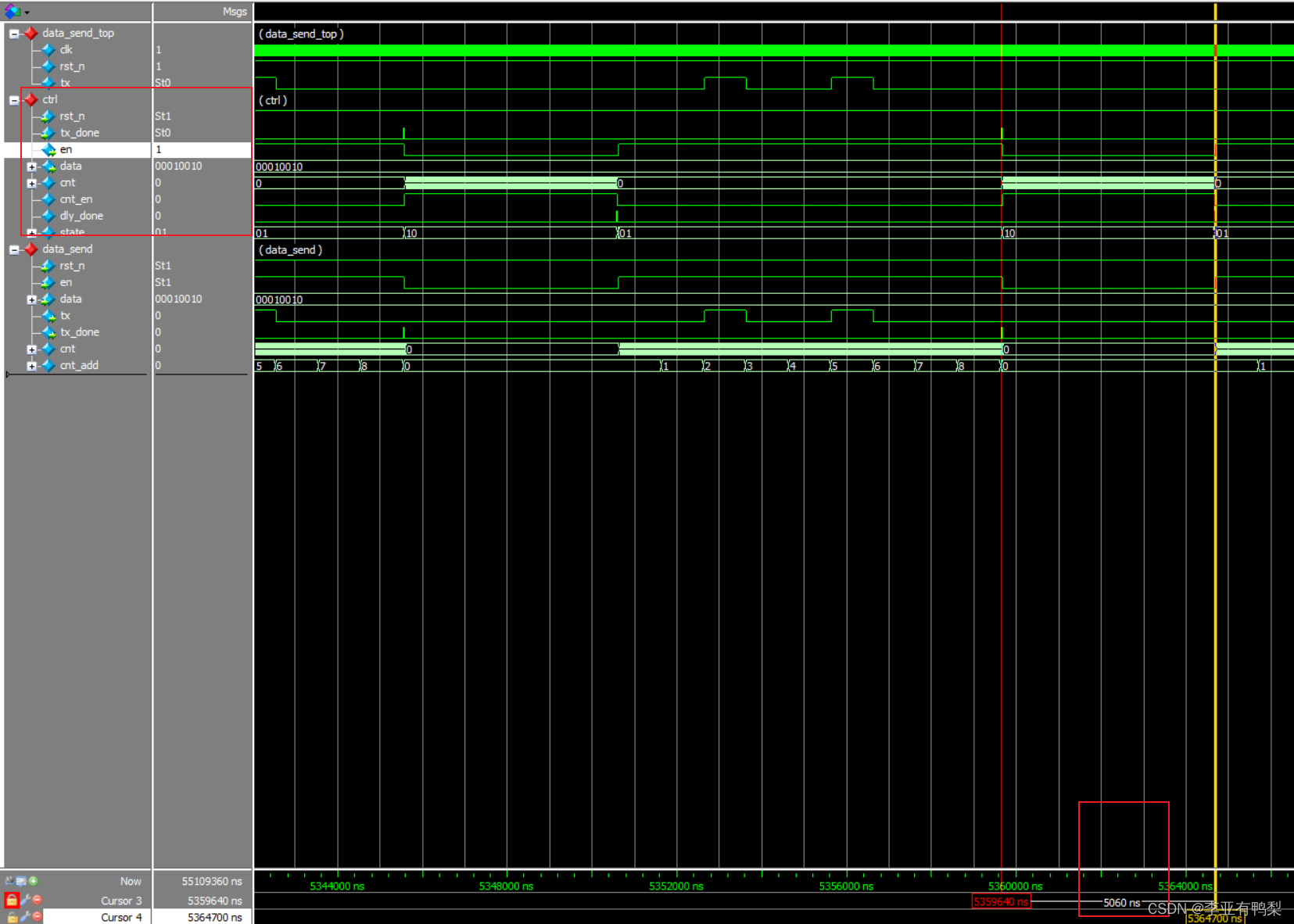
观察到dly_done信号是用时序逻辑实现会延迟一个时钟,但该信号的意义因该是计数到时立即有效,故用组合逻辑实现。结果优化了20ns。

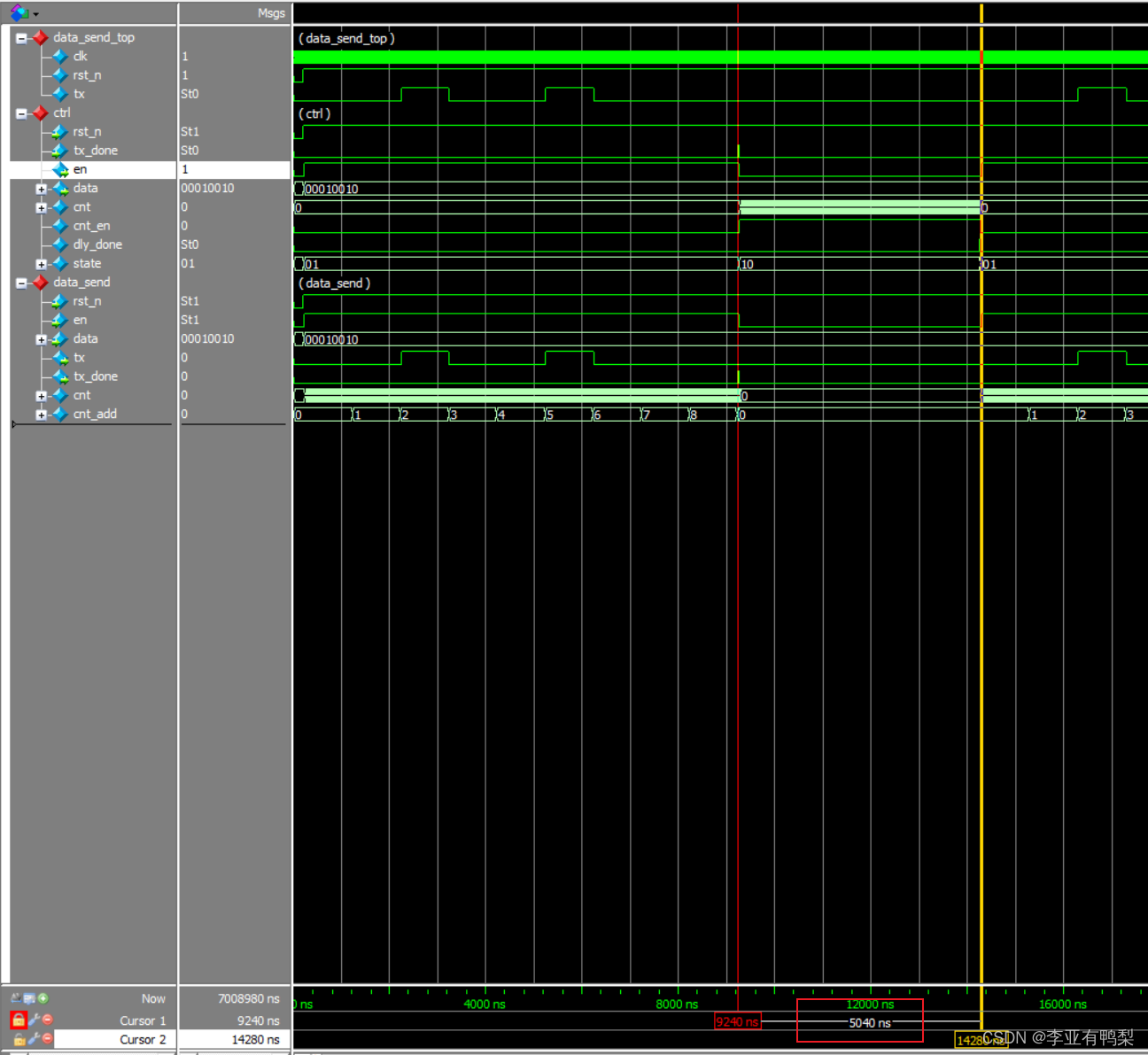
但还是存在优化空间。
四、总结
了解了线性序列机和状态机的思想和基本实现方法。
写子模块时必须要仿真验证通过才能进行下一步工作,否则之后的步骤中的错误将很难排查。
写代码之前最好将思路想好,模块分好,照图施工。








 本文介绍了如何在FPGA设计中利用线性序列机和状态机思想实现数据发送。具体地,通过一个50个时钟周期发送一字节数据的data_send模块和一个控制发送间隔的ctrl模块,确保每5000ns发送一次数据。文章详细展示了这两个模块的Verilog代码及仿真过程,并指出在ctrl模块中存在3个时钟周期的延迟问题,提出了优化方案。
本文介绍了如何在FPGA设计中利用线性序列机和状态机思想实现数据发送。具体地,通过一个50个时钟周期发送一字节数据的data_send模块和一个控制发送间隔的ctrl模块,确保每5000ns发送一次数据。文章详细展示了这两个模块的Verilog代码及仿真过程,并指出在ctrl模块中存在3个时钟周期的延迟问题,提出了优化方案。















 335
335

 被折叠的 条评论
为什么被折叠?
被折叠的 条评论
为什么被折叠?










